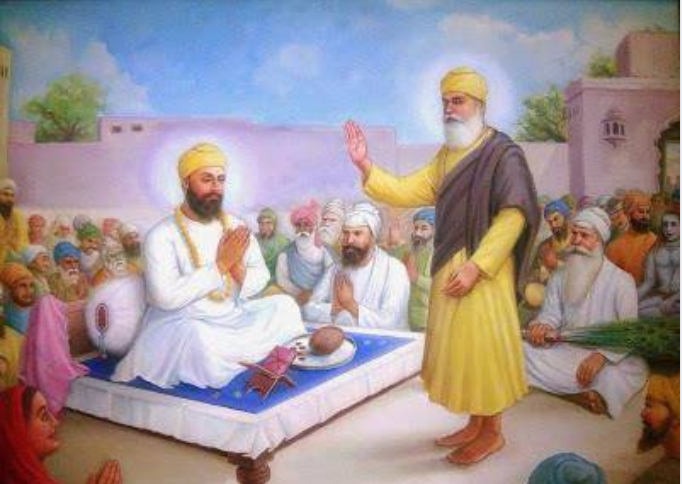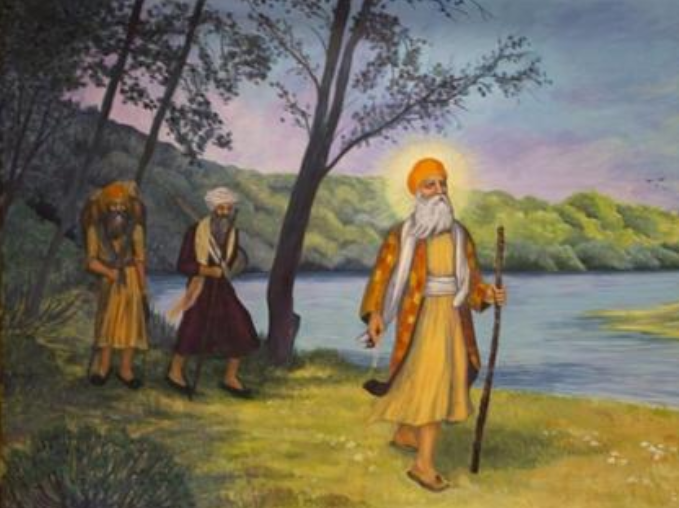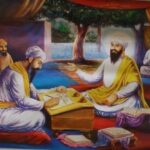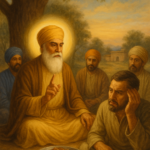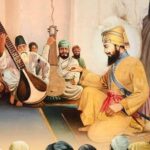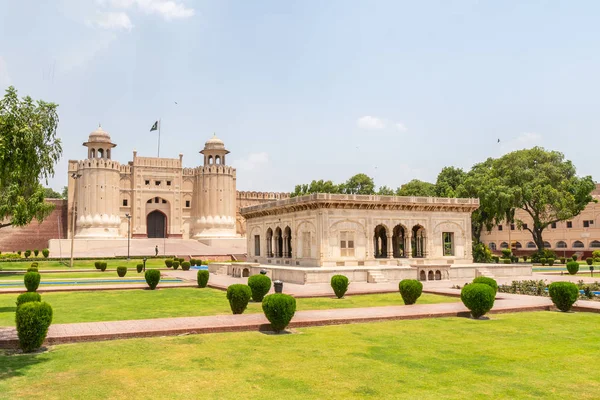Guru Nanak Dev Ji, the founder of Sikhism, lived a life woven with profound
spiritual insights and transformative encounters. From his humble
beginnings to his last moments, his journey was marked by compassion,
wisdom, and a tireless quest for truth.
Table of Contents
ToggleBirth and Early Years:
From his childhood, Guru Nanak exhibited an unusual and profound sensitivity to the suffering of others. One incident from his early years stands out: during a sacred thread ceremony at the local school, young Nanak surprised everyone. Instead of following the conventional ritual, he used the money his father had given him to buy food. Nanak then distributed this food among the less fortunate, a gesture that foreshadowed his lifelong commitment to selfless service and compassion.
This incident not only showcased Guru Nanak’s early rejection of ritualism in favor of compassionate action but also hinted at the egalitarian principles that would later define Sikhism. His actions were a reflection of his innate understanding that spirituality should be expressed through acts of kindness and service to humanity, transcending the boundaries of caste and creed.
Guru Nanak’s childhood and early years set the stage for a life dedicated to breaking down societal barriers, challenging orthodox practices, and emphasizing the universal nature of spirituality. Even in his formative years, the seeds of his revolutionary ideas were evident, laying the foundation for a profound spiritual journey that would leave an indelible mark on the course of religious history.

The Divine Call:
At the age of 30, Guru Nanak experienced a profound and transformative event that marked the beginning of his public ministry. One day, he mysteriously disappeared into the nearby River Bein and remained submerged for three days. During this time, it is believed that Guru Nanak had a divine encounter with the Supreme Being.
Upon emerging from the river, Nanak spoke the words that would echo through the ages: “There is no Hindu, there is no Muslim.” This powerful proclamation emphasized the fundamental unity of all humankind and laid the foundation for the core principles of Sikhism—equality, oneness, and a rejection of religious divisions.
Guru Nanak’s immersion in the river symbolized not only a physical cleansing but, more importantly, a spiritual rebirth. His declaration challenged the prevailing religious and social norms of the time, where divisions between Hinduism and Islam were deeply entrenched. By asserting the universal truth that transcended religious boundaries, Guru Nanak set the tone for a revolutionary spiritual movement.
The divine call not only marked the inception of Guru Nanak’s mission but also provided a philosophical framework for his teachings. He embarked on a series of journeys, traveling far and wide to spread the message of unity and devotion to the one true Creator. Guru Nanak’s divine experience at the River Bein became the guiding light for his life’s work, inspiring generations of Sikhs to embrace a path of love, humility, and inclusivity. This pivotal moment illuminated the spiritual path that Guru Nanak would tread, influencing the course of Sikh philosophy and shaping the destiny of a burgeoning religious community.

Travels and Teachings:
a. First Udasi: Guru Nanak embarked on his first Udasi, traveling towards the east. He visited various holy sites, engaged in spiritual discourses, and spread his message of love and equality. His interactions with saints, scholars, and common people enriched his understanding of different faiths and cultures.
b. Second Udasi: The second journey took Guru Nanak towards the south, covering regions like central India and Sri Lanka. His encounters during this Udasi further emphasized the universality of his teachings. In Sri Lanka, he engaged in a profound discourse with Siddhas, highlighting the importance of inner spirituality over external rituals.
c. Third Udasi: Guru Nanak’s third journey took him westward, traversing through present-day Pakistan, Afghanistan, and parts of the Middle East. Notable destinations included Baghdad and Mecca. In Mecca, Guru Nanak challenged prevailing religious practices, emphasizing the essence of true devotion over ritualistic formalities.
d. Fourth Udasi: The final leg of Guru Nanak’s travels focused on the northern regions, including Tibet. These journeys were not mere geographical explorations; they were a means to connect with people from different backgrounds, fostering a sense of unity and understanding among diverse communities.
Throughout his travels, Guru Nanak engaged in meaningful dialogues, challenging established norms and promoting the idea of a single, formless God. His teachings emphasized the importance of honest living, selfless service, and devotion to the divine. The stories from these journeys form a tapestry of wisdom, illustrating Guru Nanak’s commitment to breaking down religious barriers and fostering a sense of oneness among humanity. These travels laid the groundwork for the development of Sikhism, establishing a legacy that transcends geographical boundaries and resonates with spiritual seekers around the world.
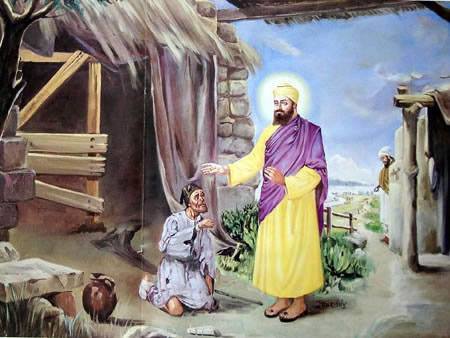
The Kartarpur Community:
a. Foundation of Kartarpur: After completing his extensive travels, Guru Nanak chose to settle in Kartarpur. Here, he, along with his disciples, laid the foundation of a community that transcended social hierarchies and religious divides. The construction of Kartarpur was not merely the laying of bricks; it was the manifestation of Guru Nanak’s vision of a society united in devotion and service.
b. Langar Tradition: A hallmark of Kartarpur was the establishment of the Langar, a community kitchen that served free meals to all, regardless of caste, creed, or social status. This revolutionary concept challenged the prevailing norms of a rigid social hierarchy, where sharing a meal was often restricted to one’s own community. Guru Nanak, through the Langar, emphasized the equality of all humanity and the breaking down of societal barriers.
c. Open Doors for All: Kartarpur became a sanctuary of spiritual enlightenment with its doors open to people of all backgrounds. Guru Nanak welcomed followers of diverse faiths, fostering an environment where dialogue and understanding flourished. This inclusive approach reflected Guru Nanak’s teachings of oneness and tolerance.
d. Gurudwara Darbar Sahib Kartarpur: The Gurudwara Darbar Sahib Kartarpur, now a revered Sikh shrine, stands as a testament to Guru Nanak’s legacy. The site holds historical significance as Guru Nanak spent the last years of his life here. The Gurudwara, with its simple yet spiritually charged architecture, attracts pilgrims from around the world.
Kartarpur represents a living embodiment of Guru Nanak’s vision for a harmonious and egalitarian society. The community he established here laid the groundwork for the development of Sikhism, emphasizing the principles of selfless service, humility, and devotion to the divine. The spirit of Kartarpur continues to resonate, inspiring Sikhs and seekers of truth to embrace a path of inclusivity and compassion.
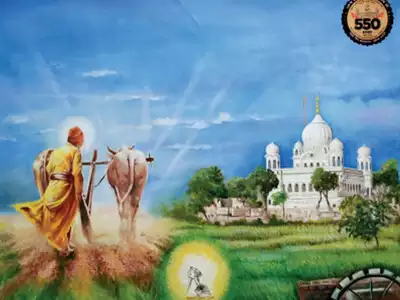
Interfaith Dialogues:
a. Encounter with Sufi Saints: During his travels, Guru Nanak engaged in meaningful dialogues with Sufi saints, who were prominent spiritual figures in the Islamic tradition. One notable encounter was with Sheikh Brahm, a Sufi mystic. Guru Nanak’s discussions with Sufi saints emphasized the commonalities between Sikhism and Sufism, particularly the emphasis on love, devotion, and the pursuit of a direct connection with the divine.
b. Discourse in Mecca: Guru Nanak’s journey to Mecca is a remarkable example of his commitment to interfaith understanding. In Mecca, he engaged in a dialogue with the Qazi, a Muslim religious leader. Guru Nanak’s message challenged the ritualistic practices of the time and emphasized the universal nature of spirituality. His teachings transcended religious boundaries, emphasizing the importance of sincere devotion and ethical living.
c. Dialogue with Hindu Scholars: Back in India, Guru Nanak engaged in discussions with Hindu scholars. One such encounter took place at Varanasi, a sacred city for Hindus. Guru Nanak’s discussions focused on emphasizing the formless nature of God, challenging anthropomorphic representations. These dialogues aimed to break down religious dogmas and promote a deeper, more universal understanding of spirituality.
d. The Bhai Lalo Incident: A famous episode in Guru Nanak’s life involves a meal shared with Bhai Lalo, a poor carpenter, over a rich feast offered by a wealthy landowner. Guru Nanak’s choice to dine with Bhai Lalo, despite the stark socioeconomic contrast, conveyed a powerful message of equality and undermined the caste-based divisions prevalent in society.
Guru Nanak’s interfaith dialogues were not attempts to convert others to Sikhism but rather opportunities to build bridges of understanding. His teachings emphasized the common essence of all religions and the shared goal of connecting with the divine. These dialogues laid the foundation for Sikhism’s inclusive nature and continue to inspire a spirit of interfaith harmony in the Sikh community today.
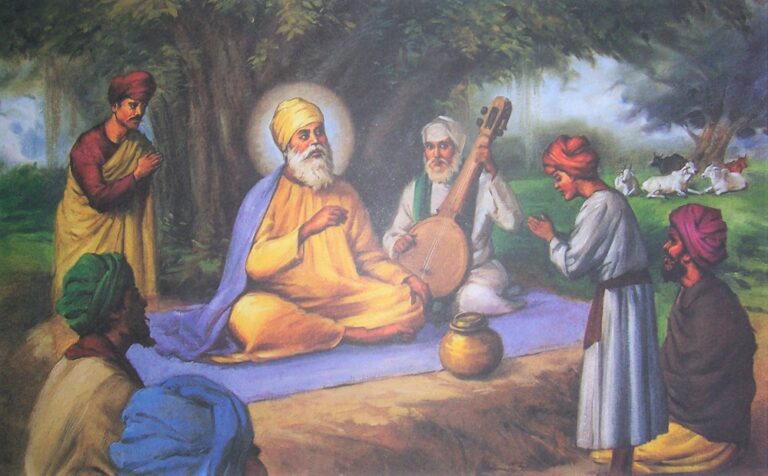
Compassion for All Beings:
Guru Nanak’s life was a testament to compassion, extending beyond human boundaries to embrace all living beings. His interactions with individuals from various backgrounds showcased a deep sense of empathy and a commitment to alleviating the suffering of both humans and animals.
a. The Sajjan Thug Transformation: One of the most compelling stories illustrating Guru Nanak’s compassion is the transformation of Sajjan Thug, a notorious criminal. Sajjan Thug would deceive travelers, offering them shelter only to rob and kill them. Guru Nanak, recognizing the potential for change in even the most hardened individual, chose to stay at Sajjan Thug’s place during his travels. Through the Guru’s divine influence and compassionate teachings, Sajjan Thug underwent a radical transformation, renouncing his criminal ways and dedicating his life to virtuous pursuits.
b. Compassion for Animals: Guru Nanak’s compassion extended to the animal kingdom as well. He spoke against needless cruelty and encouraged a lifestyle that respected all creatures. One well-known incident involves Guru Nanak intervening to protect a group of ants from being inadvertently washed away by his disciples. This small act emphasized the interconnectedness of all life and the importance of showing kindness to every living being.
c. The Story of Malik Bhago: Guru Nanak’s compassion wasn’t limited to individuals; it also extended to addressing social injustices. In the case of Malik Bhago, a wealthy landowner who exploited his workers, Guru Nanak advocated for fair treatment and ethical conduct. He emphasized the principle of honest living and condemned those who accumulated wealth through exploitation and unfair practices.
d. Equality in Langar: The establishment of the Langar, a community kitchen providing free meals to all, regardless of social status, exemplifies Guru Nanak’s commitment to equality and compassion. The Langar not only addressed the immediate need for nourishment but also symbolized the breaking down of societal barriers. Everyone, irrespective of caste or creed, sat together as equals, fostering a sense of unity and shared humanity.
Guru Nanak’s compassion was not limited to theoretical teachings; it was embedded in his actions and interactions with the world. His stories emphasize the transformative power of compassion and the potential for positive change, inspiring followers to embrace a life of empathy, kindness, and service to all living beings.
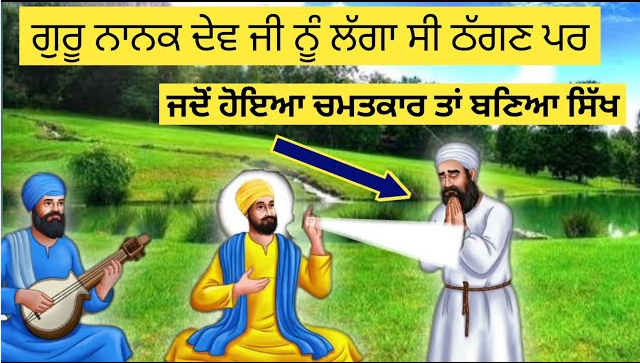
Departure from Earthly Life:
a. Appointment of Guru Angad: Realizing the importance of a successor to carry forward his spiritual legacy, Guru Nanak appointed Guru Angad Dev as his successor. This decision was not based on familial ties but on Guru Angad’s deep understanding of Guru Nanak’s teachings and his unwavering commitment to the Sikh community. Guru Nanak’s passing became a seamless transition of spiritual authority, emphasizing the principle of Guru Nanak’s divine light passing from one Guru to the next.
b. Last Words of Wisdom: Before his departure, Guru Nanak imparted his final words of wisdom to his followers. His teachings emphasized the principles of truthful living, devotion to the divine, and selfless service to humanity. Guru Nanak’s parting message underscored the eternal nature of spiritual truth and the importance of living a life guided by these timeless principles.
c. Integration into the Divine: Guru Nanak’s passing was not a conventional death; it was viewed as a merging of his divine essence with the Supreme Being. Sikhs believe that Guru Nanak’s spirit transcended the limitations of the physical body, becoming one with the formless, eternal God. This belief reflects the core Sikh understanding of the Guru as a spiritual guide whose essence remains ever-present.
d. Guru Granth Sahib: Guru Nanak’s teachings were compiled into the Guru Granth Sahib, the holy scripture of Sikhism. The Granth Sahib, which includes the writings of Guru Nanak and subsequent Sikh Gurus, serves as the eternal Guru for Sikhs. Guru Nanak’s wisdom, captured in these sacred scriptures, continues to guide and inspire millions, ensuring that his legacy endures through the pages of Sikh scripture.
Guru Nanak’s departure was not the end of his influence but rather the beginning of a spiritual legacy that would shape the course of Sikhism. His teachings, embodied in the Guru Granth Sahib, remain a source of guidance, inspiration, and solace for Sikhs around the world, reinforcing the idea that the Guru’s divine light continues to illuminate the path for all seekers of truth.
